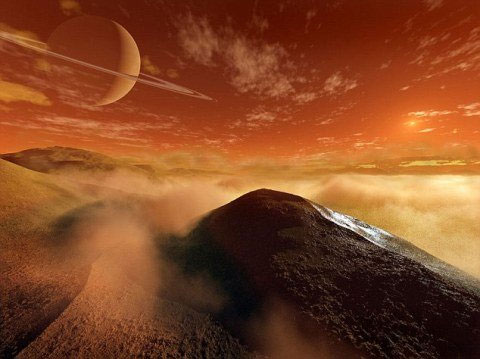Sand dunes on Titan are exactly the same on Earth
The sand dunes on the surface of Titan, Saturn's moon, are shaped like sand dunes, even very much like the deserts on Earth.
>>>The Earth-like moon is unexpected
Images from NASA's Cassini probe show that these sand dunes are rich in shape, over 90m high and 1.5km wider. However, they are composed of solid hydrocarbons, chemicals found in crude oil, not sand.

Model of giant sand dunes on Titan
Sand dunes are the second dominant terrain on Titan, covering more than 6 million square kilometers, equivalent to the size of the United States. Therefore, their formation could help scientists better understand the strange environment of this clouded planet.
Although similar in shape, Titan's sand dunes are far more massive than the Arabian or Namibian sand dunes on Earth. They average an average of 1-2 km, hundreds of kilometers long, and about 100m high. However, their different sizes and distances show that the environment they form and develop.
Using data from the exploration ship, Alice Le Gall, a former postdoctoral researcher at NASA and his collaborative rocket engine laboratory, found the size of Titan sand dunes under control by at least 2 factors: altitude and latitude. The higher the sand dunes, the thinner and farther away.
Each season on Titan lasts about 7 years. Due to Saturn's elliptical orbit, Titan's southern hemisphere has shorter summers but is warmer, resulting in lower humidity. The drier sand grains are easily washed away by the wind to form sand dunes.
Le Gall said: 'As these grains of sand move north, we believe that the moisture on the surface increases, making it harder for sand molecules to move. As a result, it is difficult to form sand dunes'.
- 70km of sand dunes date from the mysterious preserved Ice Age at the bottom of the sea
- Detailing the Moon's sand dunes Saturn
- Mysterious blue sand dunes on Mars
- What do the ghost dunes on Mars reveal about life?
- 5 threats to coastal sand dunes
- Sand dunes are leeches on Mars
- The culprit follows extruded sand dunes like the seabed
- Explore the world-like sand hill in Thousand and One Nights in Japan
- Decipher the mystery of the Morse code message on Mars
- Spectacular waves on the rocky mountains
- The mysterious whirlwind sweeps the moon of Saturn
- Sand dunes appear dense at Nha Trang beach
 Van Allen's belt and evidence that the Apollo 11 mission to the Moon was myth
Van Allen's belt and evidence that the Apollo 11 mission to the Moon was myth The levels of civilization in the universe (Kardashev scale)
The levels of civilization in the universe (Kardashev scale) Today Mars, the sun and the Earth are aligned
Today Mars, the sun and the Earth are aligned The Amazon owner announced a secret plan to build a space base for thousands of people
The Amazon owner announced a secret plan to build a space base for thousands of people